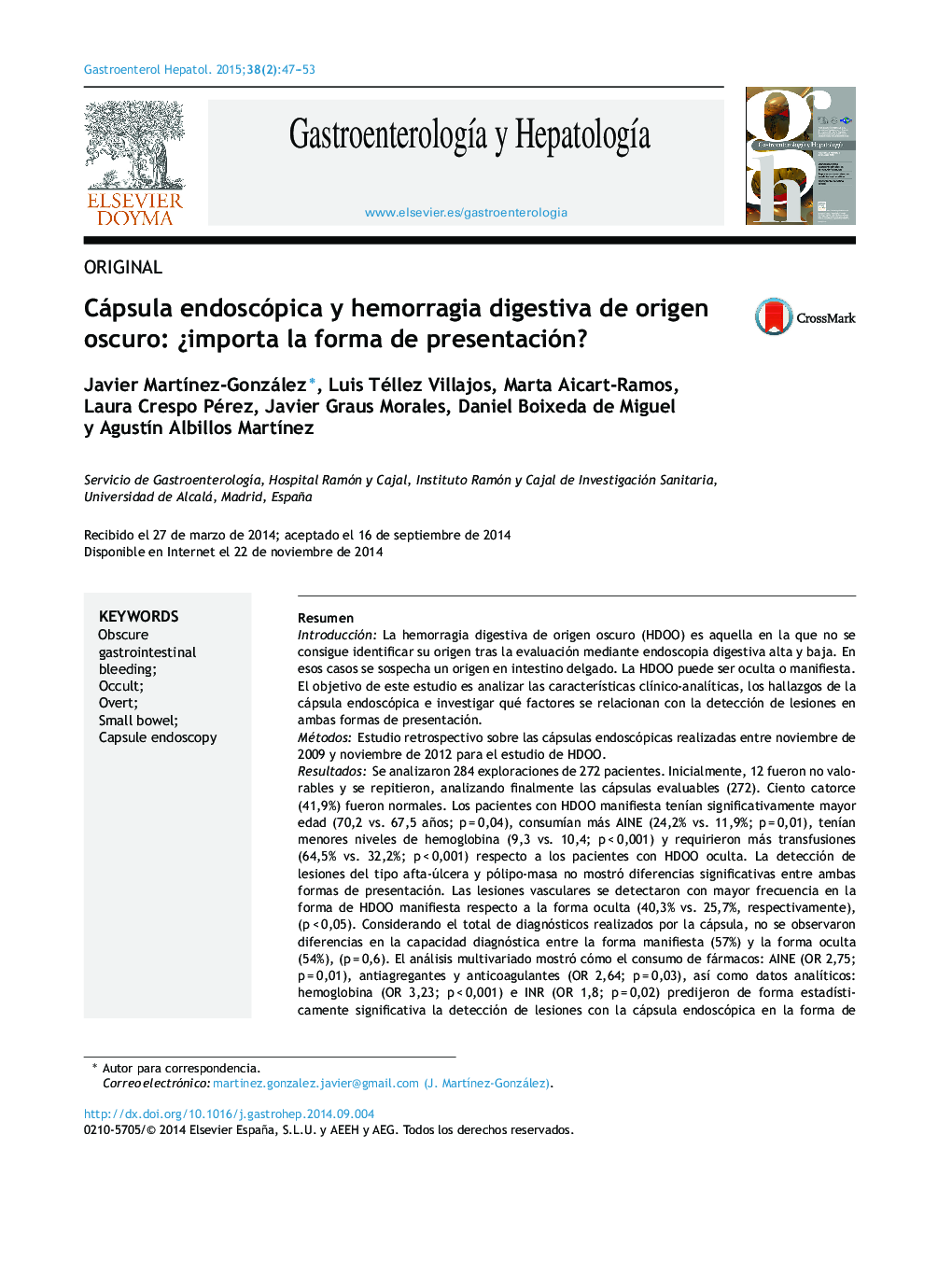| کد مقاله | کد نشریه | سال انتشار | مقاله انگلیسی | نسخه تمام متن |
|---|---|---|---|---|
| 3287820 | 1209464 | 2015 | 7 صفحه PDF | دانلود رایگان |

ResumenIntroducciónLa hemorragia digestiva de origen oscuro (HDOO) es aquella en la que no se consigue identificar su origen tras la evaluación mediante endoscopia digestiva alta y baja. En esos casos se sospecha un origen en intestino delgado. La HDOO puede ser oculta o manifiesta. El objetivo de este estudio es analizar las características clínico-analíticas, los hallazgos de la cápsula endoscópica e investigar qué factores se relacionan con la detección de lesiones en ambas formas de presentación.MétodosEstudio retrospectivo sobre las cápsulas endoscópicas realizadas entre noviembre de 2009 y noviembre de 2012 para el estudio de HDOO.ResultadosSe analizaron 284 exploraciones de 272 pacientes. Inicialmente, 12 fueron no valorables y se repitieron, analizando finalmente las cápsulas evaluables (272). Ciento catorce (41,9%) fueron normales. Los pacientes con HDOO manifiesta tenían significativamente mayor edad (70,2 vs. 67,5 años; p = 0,04), consumían más AINE (24,2% vs. 11,9%; p = 0,01), tenían menores niveles de hemoglobina (9,3 vs. 10,4; p < 0,001) y requirieron más transfusiones (64,5% vs. 32,2%; p < 0,001) respecto a los pacientes con HDOO oculta. La detección de lesiones del tipo afta-úlcera y pólipo-masa no mostró diferencias significativas entre ambas formas de presentación. Las lesiones vasculares se detectaron con mayor frecuencia en la forma de HDOO manifiesta respecto a la forma oculta (40,3% vs. 25,7%, respectivamente), (p < 0,05). Considerando el total de diagnósticos realizados por la cápsula, no se observaron diferencias en la capacidad diagnóstica entre la forma manifiesta (57%) y la forma oculta (54%), (p = 0,6). El análisis multivariado mostró cómo el consumo de fármacos: AINE (OR 2,75; p = 0,01), antiagregantes y anticoagulantes (OR 2,64; p = 0,03), así como datos analíticos: hemoglobina (OR 3,23; p < 0,001) e INR (OR 1,8; p = 0,02) predijeron de forma estadísticamente significativa la detección de lesiones con la cápsula endoscópica en la forma de HDOO manifiesta. En la forma de presentación oculta, el análisis multivariado mostró que la edad (OR 1,9; p = 0,04) y el consumo de AINE (OR 2,1; p = 0,01) estaban estadísticamente relacionados con la detección de lesiones en la cápsula.ConclusionesLa cápsula endoscópica es fundamental en la valoración de la HDOO. Aunque la capacidad diagnóstica fue similar entre ambas formas de presentación, las lesiones vasculares se detectaron con mayor frecuencia en el subtipo manifiesta. Teniendo en cuenta la forma de presentación de la HDOO (manifiesta vs. oculta) y algunas características clínico-analíticas de los pacientes (edad, consumo de fármacos, hemoglobina) se podría optimizar la capacidad diagnóstica de la cápsula.
IntroductionObscure gastrointestinal bleeding (OGIB) is defined as bleeding from the gastrointestinal tract with no obvious cause after assessment with upper and lower gastrointestinal endoscopy. In these cases, the source is suspected to be in the small bowel. Obscure bleeding can be occult or overt. The aim of this study was to analyze the clinical and analytical characteristics and findings on capsule endoscopy in patients with OGIB and to determine the factors related to the detection of lesions in both forms of presentation.MethodsWe performed a retrospective study of capsule endoscopies carried out between November 2009 and November 2012 for OGIB.ResultsWe analyzed 284 capsule endoscopies in 272 patients. Initially, 12 procedures could not be evaluated and were repeated. A total of 272 procedures were finally included in the analysis. The results of 114 (41.9%) capsule endoscopies were normal. Compared with patients with occult OGIB, those with overt OGIB were significantly older (70.2 vs. 67.5 years; p = 0.04), consumed more NSAID (24.2% vs. 11.9%; p = 0.01), had higher hemoglobin levels (9.3 vs. 10.4; p < 0,001) and more frequently required transfusion (64.5% vs 32.2%; p < 0.001). No differences were found between the two forms of presentation in the detection of canker sores-ulcers and polyps-masses. Vascular lesions were more frequently detected in overt than in occult OGIB (40.3% vs. 25.7%, respectively), (p < 0.05). When the total number of diagnoses carried out by capsule endoscopy was analyzed, no differences were found in diagnostic yield between overt OGIB (57%) and occult OGIB (54%), (p = 0.6). In overt OGIB, multivariate analysis showed that the variables that significantly predicted the detection of lesions on capsule endoscopy were consumption of medication NSAID (OR 2.75; p = 0.01), antiplatelets and anticoagulants (OR 2.64; p = 0.03) and analytical data hemoglobin (OR 3.23; p < 0.001) and INR (OR 1.8; p = 0.02). In occult OGIB, multivariate analysis showed that the factors significantly related to the detection of lesions on endoscopy were age (OR 1.9; p = 0.04) and NSAID consumption (OR 2.1; p = 0.01).ConclusionsCapsule endoscopy is essential in the assessment of OGIB. Although the diagnostic yield was similar in both forms of presentation, vascular lesions were more frequently detected in overt OGIB. The diagnostic yield of capsule endoscopy could be optimized by taking into account the form of presentation (overt vs. occult) and certain clinical and analytic data (age, drug consumption, hemoglobin).
Journal: Gastroenterología y Hepatología - Volume 38, Issue 2, February 2015, Pages 47–53